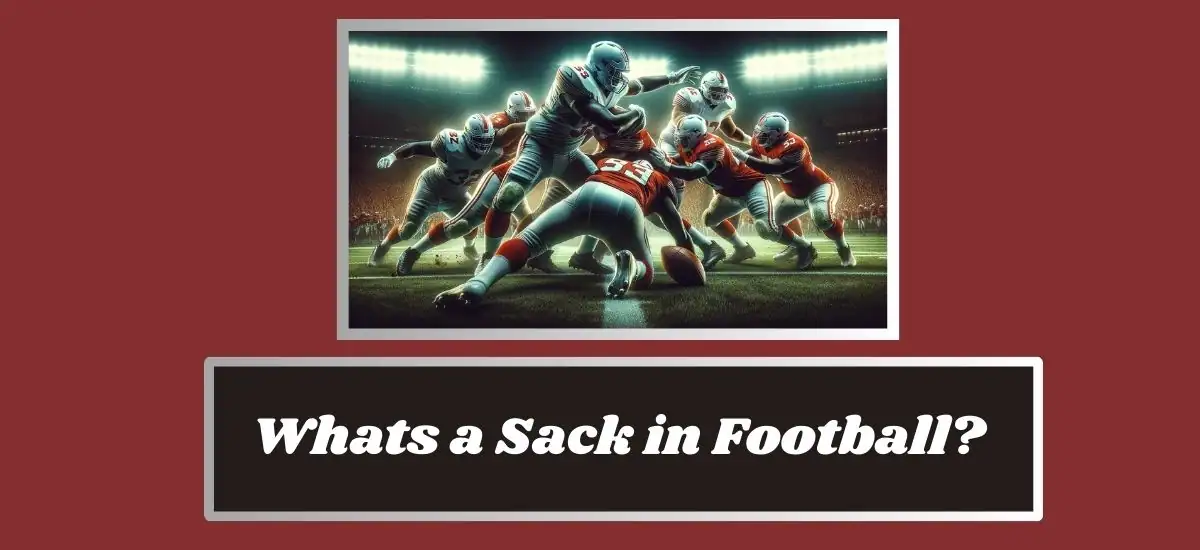
American football is a dynamic and complex sport with a rich history and an array of unique terminologies. Understanding these terms is essential for both new and seasoned fans to fully appreciate the game. One such term, “sack,” plays a crucial role in the defensive strategy and overall flow of the game.
Knowing what a sack is and how it impacts the game is fundamental to understanding football. This article will cover the definition of a sack, its historical context, the mechanics of how it occurs, and its significance in the game.
Definition of a Sack
Clear and Concise Definition of a Sack in Football:
- Sack: A sack occurs when a defensive player tackles the quarterback behind the line of scrimmage while the quarterback still has possession of the football.
Explanation of the Key Elements That Constitute a Sack:
- Behind the Line of Scrimmage: The tackle must happen behind the line where the play started.
- Quarterback Possession: The quarterback must still have the ball for the tackle to be considered a sack.
How a Sack Differs from Other Types of Tackles:
- Regular Tackle: Any tackle made on other players or the quarterback beyond the line of scrimmage.
- Tackle for Loss (TFL): Similar to a sack but can involve other offensive players like running backs or wide receivers behind the line of scrimmage.
Historical Context
Brief History of the Sack in Football:
- Early Days: The concept of sacking the quarterback has been around since the early days of football, but the term “sack” was popularized in the 1960s and 1970s.
- Terminology Evolution: The term “sack” was coined by Hall of Fame defensive end Deacon Jones, who likened tackling the quarterback to sacking a city.
Notable Changes in Rules and Terminology Over Time:
- Rule Changes: Over the years, rules have evolved to protect the quarterback, including stricter penalties for roughing the passer.
- Terminology Shifts: While the basic idea of a sack has remained consistent, the terminology and rules surrounding it have adapted to ensure player safety.
Famous Players and Moments in Sack History:
- Deacon Jones: Credited with coining the term “sack” and revolutionizing defensive play.
- Lawrence Taylor: Known for his ferocious pass-rushing ability, Taylor transformed the role of the linebacker.
- Reggie White: One of the all-time sack leaders, White’s dominance on the defensive line is legendary.
Key Milestones in Sack History
| Year | Event | Impact |
|---|---|---|
| 1960s | Deacon Jones popularizes the term “sack” | Changes how the defensive play is viewed |
| 1980s | Lawrence Taylor redefines linebacker role | Increases emphasis on pass rushing |
| 2000s | Stricter roughing the passer rules implemented | Enhances quarterback protection |
How a Sack Occurs
Step-by-Step Explanation of How a Sack Happens During a Play:
- Snap: The play begins with the center snapping the ball to the quarterback.
- Defensive Rush: Defensive linemen and linebackers rush toward the quarterback, aiming to bypass the offensive line.
- Breaking Through: Defenders use various techniques to evade or overpower blockers.
- Tackling the Quarterback: Once a defender reaches the quarterback, they must bring them down while the quarterback still holds the ball, resulting in a sack.
Role of the Defensive Line and Linebackers:
- Defensive Line: Primary role is to penetrate the offensive line and apply pressure directly to the quarterback.
- Linebackers: Often used in blitz packages, adding extra pressure and confusing the offensive line.
Key Strategies Used by Defenders to Achieve a Sack:
- Speed Rush: Using quickness to get around the offensive tackle.
- Bull Rush: Using power to push the offensive lineman backward.
- Swim Move: Using arm techniques to slip past the blocker.
- Stunts and Blitzes: Coordinated defensive plays designed to create confusion and open paths to the quarterback.
Defensive Strategies for Sacks
| Strategy | Description | Key Players Involved |
|---|---|---|
| Speed Rush | Quickness to evade offensive tackle | Defensive Ends |
| Bull Rush | Power to push blocker backward | Defensive Tackles, Ends |
| Swim Move | Arm techniques to bypass blockers | Defensive Linemen |
| Stunts and Blitzes | Coordinated plays to confuse offense | Linebackers, Defensive Linemen |
Impact of a Sack on the Game
How a Sack Affects the Offensive Team’s Momentum:
- Loss of Yardage: A sack results in negative yardage, pushing the offense further from their goal.
- Down and Distance: A sack often results in a long-yardage situation, making it harder to achieve a first down.
Statistical Impact of a Sack on Down and Distance:
- Drive Success Rate: Teams are significantly less likely to score after taking a sack.
- Third Down Efficiency: Sacks on third down often lead to punts, giving the defensive team a strategic advantage.
Psychological Impact on the Quarterback and Offensive Line:
- Quarterback: Frequent sacks can rattle the quarterback, leading to hurried throws and mistakes.
- Offensive Line: Repeated sacks can demoralize the offensive line, impacting their performance and confidence.
Impact of Sacks on Offensive Statistics
| Impact Area | Effect | Consequence |
|---|---|---|
| Loss of Yardage | Negative yardage, longer to goal | Harder to achieve first down |
| Drive Success Rate | Lower probability of scoring | Strategic advantage for defense |
| Third Down Efficiency | Decreased efficiency, more punts | Change of possession |
| Quarterback Morale | Increased pressure, potential for errors | Lower offensive effectiveness |
American Phrase Example: “When push comes to shove,” a well-timed sack can completely change the momentum of the game.
Famous Sack Artists
Profiles of Notable Players Known for Their Sack Abilities:
- Reggie White: Known as “The Minister of Defense,” White is one of the all-time sack leaders, with a career total of 198 sacks.
- Lawrence Taylor: Revolutionized the linebacker position with his aggressive pass rush, amassing 132.5 career sacks.
- Deacon Jones: Credited with coining the term “sack,” Jones was a dominant force in the 1960s and 1970s.
Career Highlights and Records Related to Sacks:
- Reggie White: Held the single-season sack record with 21 in 1987 (since broken).
- Lawrence Taylor: Two-time Super Bowl champion, NFL MVP in 1986.
- Deacon Jones: Inducted into the Pro Football Hall of Fame in 1980.
Analysis of Their Techniques and Styles:
- Reggie White: Utilized a combination of power and agility, known for his “hump move.”
- Lawrence Taylor: Relied on speed and aggression, often blitzing from the outside.
- Deacon Jones: Master of the head slap and bull rush, overwhelming offensive linemen with sheer force.
Famous Sack Artists and Their Achievements
| Player | Career Sacks | Signature Move | Achievements |
|---|---|---|---|
| Reggie White | 198 | Hump Move | Hall of Fame, Super Bowl Champion |
| Lawrence Taylor | 132.5 | Outside Blitz | Hall of Fame, NFL MVP |
| Deacon Jones | Estimated 173 | Head Slap, Bull Rush | Hall of Fame, Coined “sack” |
Rules and Regulations
Overview of NFL Rules Regarding Sacks:
- Legal Sacks: A sack is legal if the defender tackles the quarterback behind the line of scrimmage while the quarterback still has possession of the ball.
- Roughing the Passer: A penalty is called if the defender uses excessive force or hits the quarterback in a way deemed unsafe, such as hitting them in the head or below the knees.
- Intentional Grounding: If the quarterback throws the ball away to avoid a sack without a receiver in the vicinity, it can result in a penalty for intentional grounding.
Explanation of Penalties Related to Sacks:
- Roughing the Passer: Results in a 15-yard penalty and an automatic first down for the offensive team.
- Face Mask: If a defender grabs the quarterback’s face mask during a sack, it incurs a 15-yard penalty.
- Horse Collar Tackle: Tackling the quarterback by grabbing the inside collar of their shoulder pads or jersey is illegal and results in a 15-yard penalty.
Differences in Sack Rules Across Various Leagues (College Football, CFL, etc.):
- College Football: Similar rules to the NFL, with added emphasis on player safety and targeting penalties.
- Canadian Football League (CFL): Allows for more aggressive defensive play but still enforces penalties for dangerous hits on quarterbacks.
Sack-Related Penalties
| Penalty | Description | Consequence |
|---|---|---|
| Roughing the Passer | Excessive force or unsafe hit on quarterback | 15-yard penalty, automatic first down |
| Face Mask | Grabbing the face mask during a sack | 15-yard penalty |
| Horse Collar Tackle | Tackling by grabbing inside the collar | 15-yard penalty |
American Phrase Example: “When push comes to shove,” understanding the rules and regulations surrounding sacks is crucial for both players and fans.
Techniques and Strategies
Common Techniques Used by Defenders to Sack the Quarterback:
- Speed Rush: Utilizing quickness and agility to outmaneuver the offensive tackle.
- Bull Rush: Using raw strength to push the offensive lineman back into the quarterback.
- Swim Move: An arm-over move to get past the blocker.
- Spin Move: A spinning motion to evade the offensive lineman and get to the quarterback.
Training and Drills Used to Improve Sack Skills:
- Footwork Drills: Enhancing agility and balance to navigate around blockers.
- Hand Fighting: Training on using hands to disengage from blockers.
- Strength Training: Building the power needed for moves like the bull rush.
- Film Study: Analyzing opponents’ weaknesses and tendencies.
Role of Coaching in Developing Effective Pass Rushers:
- Technique Refinement: Coaches work with players to perfect their sack techniques.
- Game Planning: Developing strategies that exploit the offensive line’s weaknesses.
- Motivation and Mental Preparation: Preparing players mentally for the rigors of the game and the persistence required to achieve sacks.
Sack Techniques and Training
| Technique | Description | Training Methods |
|---|---|---|
| Speed Rush | Using quickness to evade blockers | Footwork drills, agility training |
| Bull Rush | Pushing blocker back with strength | Strength training, power drills |
| Swim Move | Arm-over technique to bypass blockers | Hand fighting drills, technique practice |
| Spin Move | Spinning to evade the offensive lineman | Footwork drills, balance training |
Statistical Analysis
Key Statistics Related to Sacks:
- Sack Yards: The total yardage lost by the offensive team due to sacks.
- Sack Rate: The percentage of dropbacks that result in a sack.
- Hurries and Pressures: Metrics that indicate how often a defender disrupts the quarterback even without achieving a sack.
How Sacks Are Recorded and Tracked in Official Stats:
- Statistical Tracking: Recorded by official scorers during the game and included in both team and individual statistics.
- Advanced Metrics: Used by analysts to evaluate the effectiveness of pass rushers beyond just the number of sacks.
Use of Advanced Metrics to Evaluate Sack Performance:
- Pressure Rate: Measures the frequency with which a defender pressures the quarterback.
- Win Rate: Indicates how often a defender beats their blocker to create pressure.
- Pass Rush Productivity: Combines sacks, hits, and hurries per pass rush attempt to give a comprehensive measure of effectiveness.
Key Sack Statistics
| Statistic | Description | Importance |
|---|---|---|
| Sack Yards | Total yardage lost due to sacks | Indicates defensive impact |
| Sack Rate | Percentage of dropbacks resulting in a sack | Measures defensive efficiency |
| Pressure Rate | Frequency of quarterback pressures | Evaluates overall pass rush effectiveness |
| Win Rate | Frequency of beating the blocker | Assesses individual defender performance |
| Pass Rush Productivity | Combines sacks, hits, and hurries per attempt | Comprehensive effectiveness metric |
American Phrase Example: “When it comes down to brass tacks,” the advanced metrics provide a deeper understanding of a defender’s impact beyond just sack totals.
The Evolution of the Sack
How the Role of the Sack Has Evolved with Changes in Offensive Strategies:
- Increased Passing: As passing has become more prevalent, the importance of sacking the quarterback has increased.
- Spread Offenses: The rise of spread offenses has led to quicker passes, making it harder to achieve sacks but increasing the importance of quick pressure.
Impact of Rule Changes on the Frequency and Style of Sacks:
- Quarterback Protection: Rule changes to protect quarterbacks have made certain sack techniques illegal, affecting how defenders approach the game.
- Roughing the Passer Penalties: Stricter enforcement has changed how defenders aim to sack quarterbacks, focusing more on legal hits.
Future Trends in Sack Statistics and Defensive Strategies:
- Increased Use of Analytics: Teams are increasingly using advanced metrics to evaluate and improve their pass rush strategies.
- Hybrid Players: The development of players who can both rush the passer and cover receivers, adding versatility to defensive schemes.
- Emphasis on Speed: As offenses get faster, so must defenses, leading to an increased emphasis on speed and agility in pass rushers.
Evolution and Future Trends of the Sack
| Evolution/Trend | Description | Impact on Game |
|---|---|---|
| Increased Passing | More passing plays increase sack opportunities | Elevates the importance of pass rush |
| Spread Offenses | Quicker passes challenge sack timing | Requires faster defensive pressure |
| Rule Changes | Protect quarterbacks, change sack techniques | Alters defensive strategies |
| Use of Analytics | Advanced metrics for evaluating pass rush | Improves strategic planning |
| Hybrid Players | Versatile players who can rush and cover | Adds complexity to defensive schemes |
| Emphasis on Speed | Faster players needed to match offensive pace | Enhances overall defensive effectiveness |
Conclusion
Recap of Key Points:
- A sack is a critical defensive play where a defender tackles the quarterback behind the line of scrimmage.
- Understanding the definition, historical context, techniques, and rules surrounding sacks enhances appreciation for the game.
- Notable players and strategic insights highlight the significance and impact of sacks in football.
Final Thoughts on the Significance of Sacks in Football:
- Sacks are game-changing plays that can shift momentum, demoralize the offense, and elevate the defense.
- The evolution of the sack reflects broader changes in the sport, including increased emphasis on quarterback protection and advanced defensive strategies.
Invitation for Readers to Share Their Opinions or Experiences:
- Share your favorite sack moments or insights on defensive strategies in football. Join the conversation using #FootballSacks and let us know your thoughts.
FAQs
Addressing Common Questions Related to Sacks in Football:
Q: What is a sack in football? A: A sack occurs when a defensive player tackles the quarterback behind the line of scrimmage while the quarterback still has possession of the ball.
Q: How is a sack different from a regular tackle? A: A sack specifically involves tackling the quarterback behind the line of scrimmage, while a regular tackle can occur anywhere on the field and involve any player.
Q: What are some penalties associated with sacks? A: Penalties can include roughing the passer, face mask, and horse collar tackle, all of which carry yardage penalties and can impact the defensive play.
Q: Who are some famous players known for their sack abilities? A: Notable players include Reggie White, Lawrence Taylor, and Deacon Jones, each known for their exceptional pass-rushing skills.








